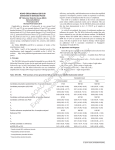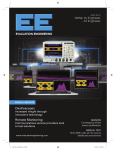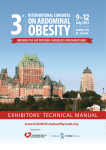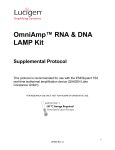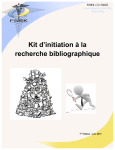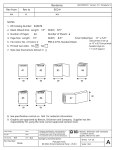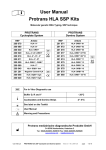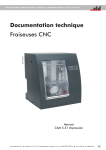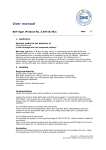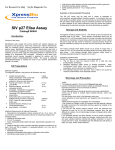Download Evaluation of 3M Molecular Detection Assay (MDA) Salmonella for
Transcript
Bird et al.: Journal of AOAC International Vol. 96, No. 6, 2013 1 FOOD BIOLOGICAL CONTAMINANTS Evaluation of 3M™ Molecular Detection Assay (MDA) Salmonella for the Detection of Salmonella in Selected Foods: Collaborative Study Patrick Bird, Kiel Fisher, Megan Boyle, Travis Huffman, M. Joseph Benzinger, Jr, Paige Bedinghaus, Jonathan Flannery, Erin Crowley, James Agin, and David Goins Q Laboratories, Inc., 1400 Harrison Ave, Cincinnati, OH 45214 DeAnn Benesh1 and John David 3M Food Safety Department, 3M Center, Bldg 260-6B-01, St. Paul, MN 55144 Collaborators: D. Awad, M. Bandu, K. Blanchard, D. Bosco, R. Brooks, D. Clark Jr, H. Dammann, J. Dyszel, V. Gill, M. Greenwell, C. Gwinn, M. Horan, J. Jurgens, M. Kelly, D. Lewis, S. Luce, J. Marchent, W. McMahon, I. Mello, S. Montez, S. Moosekian, A. Morey, K. Newman, M. Oltman, M. Ontiberos, K. Rajkowski, J. Ruebl, B. Stawick, L. Thompson, M. Vross The 3M™ Molecular Detection Assay (MDA) Salmonella is used with the 3M™ Molecular Detection System for the detection of Salmonella spp. in food, food-related, and environmental samples after enrichment. The assay utilizes loopmediated isothermal amplification to rapidly amplify Salmonella target DNA with high specificity and sensitivity, combined with bioluminescence to detect the amplification. The 3M MDA Salmonella method was compared using an unpaired study design in a multilaboratory collaborative study to the U.S. Department of Agriculture/Food Safety and Inspection Service-Microbiology Laboratory Guidebook (USDA/FSIS-MLG 4.05), Isolation and Identification of Salmonella from Meat, Poultry, Pasteurized Egg and Catfish Products for raw ground beef and the U.S. Food and Drug Administration/Bacteriological Analytical Manual (FDA/BAM) Chapter 5 Salmonella reference method for wet dog food following the current AOAC guidelines. A total of 20 laboratories participated. For the 3M MDA Salmonella method, raw ground beef was analyzed using 25 g test portions, and wet dog food was analyzed using 375 g test portions. For the reference methods, 25 g test portions of each matrix were analyzed. Each matrix was artificially contaminated with Salmonella at three inoculation levels: an uninoculated control level (0 CFU/test portion), a low inoculum level (0.2–2 CFU/test portion), and a high inoculum level (2–5 CFU/test portion). In this study, 1512 unpaired replicate samples were analyzed. Statistical analysis was conducted according to the probability of detection (POD). For the low-level raw ground beef test portions, the following dLPOD (difference between the POD of the reference and candidate method) Submitted for publication June 28, 2013. 1 Corresponding author’s e-mail: [email protected] Appendixes are available on the J. AOAC Int. website, http://aoac. publisher.ingentaconnect.com/content/aoac/jaoac DOI: 10.5740/jaoacint.13-227 values with 95% confidence intervals were obtained: –0.01 (–0.14, +0.12). For the low-level wet dog food test portions, the following dLPOD with 95% confidence intervals were obtained: –0.04 (–0.16, +0.09). No significant differences were observed in the number of positive samples detected by the 3M MDA Salmonella method versus either the USDA/FSIS-MLG or FDA/BAM methods. F or over 100 years, Salmonella, one of the most frequently reported causes of foodborne outbreaks, has been known to cause foodborne illness in humans (1). The bacterium has been implicated in outbreaks from a variety of foods including raw animal products, such as meat, poultry, eggs, dairy products, seafood, and some fruits and vegetables (2). In order to reduce outbreaks of Salmonellosis, a comprehensive farm-to-fork approach is needed. The detection of Salmonella can often be very time-consuming and expensive, as the presence of the microorganism in food usually does not affect the taste, smell, or appearance (3). The 3M™ Molecular Detection Assay (MDA) Salmonella method, in conjunction with 3M Buffered Peptone Water ISO (BPW ISO; 4), uses a combination of loopmediated isothermal DNA amplification and bioluminescence detection to detect Salmonella in enriched food, feed, and environmental samples. The 3M MDA Salmonella method allows for next-day detection of Salmonella species. After 18–24 h of enrichment using prewarmed (37 ± 1°C) 3M BPW ISO medium, Salmonella detection is performed by the 3M MDA Salmonella method. Presumptive positive results are reported in real time; negative results are displayed after completion of the assay. Prior to the collaborative study, the 3M MDA Salmonella method was certified as a Performance Tested Method (PTM) following the AOAC guidelines for harmonized PTM studies (5). The aim of the PTM study was to demonstrate that the 3M MDA Salmonella method could detect Salmonella in selected foods as claimed by the manufacturer. For the 3M MDA Salmonella evaluation, six matrices were analyzed: raw ground beef (25 g), processed breaded chicken (325 g), liquid egg (100 g), shrimp (25 g), fresh spinach (25 g), and wet dog food (375 g). All other 2 Bird et al.: Journal of AOAC International Vol. 96, No. 6, 2013 PTM parameters (inclusivity, exclusivity, ruggedness, stability, and lot-to-lot variability) tested in the PTM studies satisfied the performance requirements for PTM approval. The method was awarded PTM certification number 031208 on March 30, 2012. The aim of this collaborative study was to compare the 3M MDA Salmonella method to the U.S. Department of Agriculture (USDA) Food Safety and Inspection Service (FSIS)-Microbiology Laboratory Guidebook (MLG) 4.05 (6) for raw ground beef and the U.S. Food and Drug Administration (FDA) Bacteriological Analytical Manual (BAM) Chapter 5 (7) method for wet dog food. Collaborative Study Study Design For this collaborative study, two matrices, raw ground beef (80% lean) and wet dog food (canned beef chunks), were analyzed. The matrices were obtained from local retailers and screened for the absence of Salmonella by preparing one bulk sample and analyzing five sample replicates (25 g) by the appropriate reference method. The screening indicated an absence of the target organism. The raw ground beef was artificially contaminated with Salmonella Ohio Sequence Types (STS) 81 and the wet dog food with Salmonella Poona National Collection of Type Cultures (NCTC) 4840. There were two inoculation levels for each matrix: a high inoculation level of approximately 2–5 CFU/test portion and a low inoculation level of approximately 0.2–2 CFU/test portion. A set of uninoculated control test portions was also included for each matrix at 0 CFU/test portion. Twelve replicate samples from each of the three contamination levels of product were analyzed. Two sets of samples (72 total) were sent to each laboratory for analysis by the 3M MDA Salmonella method and either the USDA/FSIS-MLG (raw ground beef) or FDA/BAM (wet pet food) reference method due to different sample enrichments for the candidate method and the reference methods. For both matrices, collaborators were sent an additional 30 g test portion and instructed to conduct a total aerobic plate count (APC) following the FDA/BAM Chapter 3 on the day samples were received to determine the total aerobic microbial load. A detailed collaborative study packet outlining all necessary information related to the study including media preparation, method-specific test portion preparation, and documentation of results was sent to each collaborating laboratory prior to the initiation of the study. Preparation of Inocula and Test Portions The Salmonella cultures used in this evaluation were propagated in 10 mL of Brain Heart Infusion broth from a Q Laboratories frozen stock culture held at –70°C. The broth was incubated for 18–24 h at 35 ± 1°C. Appropriate dilutions were prepared based on previously established growth curves for both low and high inoculation levels, resulting in fractional positive outcomes for at least one level. For both test portion sizes, a bulk lot of each matrix was inoculated with a liquid inoculum and mixed thoroughly by hand-kneading to ensure an even distribution of microorganisms. The matrices were inoculated on the day of shipment so that all test portions would be held for 96 h before testing was initiated. For analysis of the raw ground beef, the bulk lot of test material was divided into 30 g portions for shipment to the collaborators. For analysis of the wet dog food, 25 g of inoculated test product was mixed with 350 g of uninoculated test product for shipment to the collaborators for analysis by the 3M MDA Salmonella method. For analysis by the reference method, collaborators received 30 g portions. To determine the level of Salmonella spp. in the matrices, a five-tube most probable number (MPN) was conducted by the coordinating laboratory on the day of initiation of analysis using the FDA/BAM Chapter 5 reference method for wet pet food or the USDA/FSIS-MLG 4.05 reference method for raw ground beef. From both the high and low inoculated levels, five 100 g test portions, the reference method test portions, and five 10 g test portions were analyzed using the appropriate reference method enrichment broth. The MPN and 95% confidence intervals were calculated from the high, low, and uninoculated levels using the MPN Calculator (www.lcfltd.com/customer/ LCFMPNCalculator.exe; 8). Confirmation of the samples was conducted according to either the USDA/FSIS-MLG 4.05 or FDA/BAM Chapter 5 reference method, dependent on the matrix. Test Portion Distribution All samples were labeled with a randomized, blind-coded three-digit number affixed to the sample container. Test portions were shipped on a Thursday via overnight delivery according to the Category B Dangerous Goods shipment regulations set forth by the International Air Transport Association. All samples were packed with cold packs to target a temperature of <7°C during shipment. Upon receipt, samples were held by the collaborating laboratory at refrigerated temperature (3–5°C) until the following Monday, when analysis was initiated. In addition to each of the test portions and the total plate count replicate, collaborators also received a test portion for each matrix labeled as “temperature control.” Participants were instructed to record the temperature of this portion upon receipt of the shipment, document the results on the Sample Receipt Confirmation form provided, and fax to the Study Director. Additional shipments of raw ground beef test portions were made by the sponsoring laboratory when aberrant results were observed. Further investigation of the results indicated that each participating collaborator detected the presence of the target analyte in the uninoculated control samples sent in the first shipment. In each case, the same species was reported for the control samples, which may have been due to cross-contamination. As a result, new test portions of raw ground beef were shipped and analyzed by each of the collaborating laboratories. Test Portion Analysis Collaborators followed the appropriate preparation and analysis protocol according to the method for each matrix. For both matrices, each collaborator received 72 test portions of each food product (12 high, 12 low, and 12 controls for each method). For the analysis of the raw ground beef test portions by the 3M MDA Salmonella method, a 25 g portion was enriched with 225 mL of prewarmed (37 ± 1°C) 3M BPW Bird et al.: Journal of AOAC International Vol. 96, No. 6, 2013 3 ISO, homogenized for 2 min and incubated for 18 h at 37 ±1°C. For the wet dog food test portions analyzed by the 3M MDA Salmonella method, a 375 g portion was enriched with 3375 mL prewarmed (37 ± 1°C) 3M BPW ISO, homogenized for 2 min and incubated for 18 h at 37 ± 1°C. Following enrichment, samples were assayed by the 3M MDA Salmonella method and confirmed following the standard reference method. Both test portion sizes analyzed by the 3M MDA Salmonella method were compared to samples (25 g) analyzed using either the USDA/FSIS-MLG or FDA/BAM reference method in an unpaired study design. All positive test portions were biochemically confirmed by the API 20E biochemical test, AOAC Official Method 978.24, or by the VITEK 2 GN identification test, AOAC Official Method 2011.17. Serological testing was also performed. Statistical Analysis Each collaborating laboratory recorded results for the reference method and the 3M MDA Salmonella method on the data sheets provided. The data sheets were submitted to the Study Director at the end of each week of testing for analysis. The results of each test portion for each sample were compiled by the Study Director and the qualitative 3M MDA Salmonella results were compared to the reference method for statistical analysis. Data for each test portion size were analyzed using the probability of detection (POD; 9). If the confidence interval of a dLPOD did not contain zero, then that would indicate a statistically significant difference between the candidate method and the reference method at the 5% confidence level (9). AOAC Official Method 2013.09 Salmonella in Selected Foods 3M™ Molecular Detection Assay (MDA) Salmonella Method First Action 2013 [Applicable to detection of Salmonella in raw ground beef (25 g), processed breaded chicken (325 g), liquid egg (100 g), shrimp (25 g), fresh spinach (25 g), and wet dog food (375 g)]. See Tables 2013.09A and B for a summary of results of the inter-laboratory study. See Appendix Tables A and B for detailed results of the interlaboratory study. A. Principle The 3M Molecular Detection Assay (MDA) Salmonella method is intended for use with the 3M Molecular Detection System for the rapid and specific detection of Salmonella spp. in food, feed, and environmental samples after enrichment. After enrichment in prewarmed 3M Buffered Peptone Water ISO (3M BPW ISO) medium, the 3M MDA Salmonella test utilizes loopmediated isothermal amplification to rapidly amplify Salmonella target DNA with high specificity and sensitivity, combined with bioluminescence to detect the amplification. Presumptive positive results are reported in real time; negative results are displayed after the assay is completed. B. Apparatus and Reagents Items (b)–(g) are available as the 3M MDA Salmonella kit from 3M Food Safety (St. Paul, MN). (a) 3M Molecular Detection System.—Available from 3M Food Safety. (b) 3M MDA Salmonella reagent tubes.—12 strips of eight tubes. (c) Lysis solution (LS) tubes.—12 strips of eight tubes. (d) Extra caps.—12 strips of eight caps. (e) Negative control (NC).—One vial (2 mL). (f) Reagent control (RC).—Eight reagent tubes. (g) Quick start guide. (h) 3M Molecular Detection Speed Loader Tray.—Available from 3M Food Safety. (i) 3M Molecular Detection Chill Block Tray and Chill Block Insert.—Available from 3M Food Safety. (j) 3M Molecular Detection Heat Block Insert.—Available from 3M Food Safety. (k) 3M Molecular Detection Cap/Decap Tool for reagent tubes.—Available from 3M Food Safety. (l) 3M Molecular Detection Cap/Decap Tool for lysis tubes.—Available from 3M Food Safety. (m) Empty lysis tube rack.—Available from 3M Food Safety. (n) Empty reagent tube rack.—Available from 3M Food Safety. (o) 3M BPW ISO.—Available from 3M Food Safety. Formulation equivalent to ISO 6579:2002 Annex B (4). (p) Disposable pipet.—Capable of 20 µL. (q) Multichannel (eight-channel) pipet.—Capable of 20 µL. (r) Sterile filter tip pipet tips.—Capable of 20 µL. (s) Filter stomacher bags.—Seward Laboratory Systems Inc., Bohemia, NY, or equivalent. (t) Stomacher.—Seward Laboratory Systems Inc. or equivalent. (u) Thermometer.—Calibrated range to include 100 ± 1°C. (v) Dry double block heater unit or water bath.—Capable of maintaining 100 ± 1°C. (w) Incubators.—Capable of maintaining 37 ± 1°C. (x) Freezer.—Capable of maintaining –10 to –20°C, for storing the 3M Molecular Detection Chill Block Tray. (y) Refrigerator.—Capable of maintaining 2–8°C, for storing the 3M MDA. (z) Computer.—Compatible with the 3M Molecular Detection Instrument. C. General Instructions (a) Store the 3M MDA Salmonella kit at 2–8°C. Do not freeze. Keep kit away from light during storage. After opening the kit, check that the foil pouch is undamaged. If the pouch is damaged, do not use. After opening, unused reagent tubes should always be stored in the resealable pouch with the desiccant inside to maintain stability of the lyophilized reagents. Store resealed pouches at 2–8°C for no longer than 60 days. Do not use 3M MDA Salmonella past the expiration date. (b) The 3M Molecular Detection Instrument is intended for use with samples that have undergone heat treatment during the assay lysis step, which is designed to destroy organisms present in the sample. Samples that have not been properly heat-treated during the assay lysis step may be considered a potential 4 Bird et al.: Journal of AOAC International Vol. 96, No. 6, 2013 Table 2013.09A. POD summary of raw ground beef (25 g) results for the 3M MDA Salmonella methoda Inoculation level Uninoculated Candidate presumptive positive/total No. of samples analyzed Candidate presumptive (CP) POD b sr c Low High 1/120 69/120 120/120 0.01 (0.00, +0.05) 0.58 (+0.48, +0.67) 1.00 (+0.97, +1.00) 0.09 (+0.08, +0.17) 0.51 (+0.45, +0.52) 0.00 (0.00, +0.18) sL 0.00 (0.00, +0.04) 0.00 (0.00, +0.14) 0.00 (0.00, +0.18) s Rd 0.09 (+0.08, +0.10) 0.51 (+0.45, +0.52) 0.00 (0.00, +0.24) 0/120 67/120 120/120 Candidate confirmed positive/total No. of samples analyzed Candidate confirmed (CC) POD 0.00 (0.00, +0.03) 0.56 (+0.47, +0.65) 1.00 (+0.97, +1.00) b 0.00 (0.00, +0.17) 0.51 (+0.45, +0.52) 0.00 (0.00, +0.18) sL c 0.00 (0.00, +0.17) 0.00 (0.00, +0.11) 0.00 (0.00, +0.18) s Rd 0.00 (0.00, +0.24) 0.51 (+0.46, +0.52) 0.00 (0.00, +0.24) sr 0/120 68/120 119/120 Reference POD Positive reference samples/total No. of samples analyzed 0.00 (0.00, +0.03) 0.57 (+0.48, +0.66) 0.99 (+0.95, +1.00) srb 0.00 (0.00, +0.17) 0.50 (+0.45, +0.52) 0.09 (+0.08, +0.17) sLc 0.00 (0.00, +0.17) 0.00 (0.00, +0.18) 0.00 (0.00, +0.04) d 0.00 (0.00, +0.24) 0.51 (+0.45, +0.52) 0.09 (+0.08, –0.11) dLPOD (Candidate vs Reference) 0.00 (–0.03, +0.03) –0.01 (–0.14, +0.12) 0.01 (–0.02, +0.05) dLPOD (CP vs CC) 0.01 (–0.02, +0.05) 0.02 (–0.11, +0.15) 0.00 (–0.03, +0.03) sR a Results include 95% confidence intervals. b Repeatability SD. c Among-laboratory SD. d Reproducibility SD. biohazard and should not be inserted into the 3M Molecular Detection Instrument. (c) Follow all instructions carefully. Failure to do so may lead to inaccurate results. (d) After use, the enrichment medium and the 3M MDA Salmonella tubes can potentially contain pathogenic materials. When testing is complete, follow current industry standards for the disposal of contaminated waste. Consult the Material Safety Data Sheet for additional information and local regulations for disposal. Periodically decontaminate laboratory benches and equipment (pipets, cap/decap tools, etc.) with a 1–5% (v/v in water) household bleach solution or DNA removal solution. D. Sample Enrichment Prewarm 3M BPW ISO enrichment medium to 37 ± 1°C. Aseptically combine the enrichment medium and sample following the outline in Table 2013.09C. For all meat and highly particulate samples, the use of filter bags is recommended. Homogenize thoroughly for 2 min. Incubate at 37 ± 1°C. E. Preparation of the 3M Molecular Detection Speed Loader Tray Wet a cloth or paper towel with a 1–5% (v/v in water) household bleach solution and wipe the 3M Molecular Detection Speed Loader Tray. Rinse the tray with water. Use a disposable towel to wipe the tray dry. Ensure the 3M Molecular Detection Speed Loader Tray is dry before use. F. Preparation of the 3M Molecular Detection Chill Block Insert Before using the 3M Molecular Detection Chill Block Insert, ensure it has been stored on the 3M Molecular Detection Chill Block Tray in the freezer (–10 to –20°C) for a minimum of 2 h before use. When removing the 3M Molecular Detection Chill Block Insert from the freezer for use, remove it and the 3M Molecular Detection Chill Block Tray together. Use the insert and tray within 20 min. G. Preparation of the 3M Molecular Detection Heat Block Insert Place the 3M Molecular Detection Heat Block Insert in a dry double block heater unit. Turn on the dry block heater unit and set the temperature to allow the 3M Molecular Detection Heat Block Insert to reach and maintain a temperature of 100 ± 1°C. Note: Depending on the heater unit, allow approximately 30–50 min for the 3M Molecular Detection Heat Block Insert to reach temperature. Using a calibrated thermometer, verify that the 3M Molecular Detection Heat Block Insert is at 100 ± 1°C. Bird et al.: Journal of AOAC International Vol. 96, No. 6, 2013 5 Table 2013.09B. POD Summary of wet pet food (375 g) results for the 3M MDA Salmonella methoda Inoculation level Uninoculated Low High 1/132 65/132 131/132 0.01 (0.00, +0.04) 0.49 (+0.40, +0.58) 0.99 (+0.96, +1.00) 0.09 (+0.08, +0.16) 0.51 (+0.46, +0.52) 0.09 (+0.08, +0.16) Candidate presumptive positive/total No. of samples analyzed Candidate presumptive (CP) POD b sr c sL 0.00 (0.00, +0.04) 0.00 (0.00, +0.14) 0.00 (0.00, +0.04) sRd 0.09 (+0.08, +0.10) 0.51 (+0.46, +0.52) 0.09 (+0.08, +0.10) 0/132 65/132 131/132 Candidate confirmed (CC) POD Candidate confirmed positive/total No. of samples analyzed 0.00 (0.00, +0.03) 0.49 (+0.40, +0.58) 0.99 (+0.96, +1.00) srb 0.00 (0.00, +0.17) 0.51 (+0.46, +0.52) 0.09 (+0.08, +0.16) sLc 0.00 (0.00, +0.17) 0.00 (0.00, +0.14) 0.00 (0.00, +0.04) d 0.00 (0.00, +0.23) 0.51 (+0.46, +0.52) 0.09 (+0.08, +0.10) 0/132 70/132 132/132 sR Positive reference samples/total No. of samples analyzed Reference POD 0.00 (0.00, +0.03) 0.53 (+0.44, +0.62) 1.00 (+0.97, +1.00) b 0.00 (0.00, +0.17) 0.52 (+0.46, +0.52) 0.00 (0.00, +0.17) c 0.00 (0.00, +0.17) 0.00 (0.00, +0.09) 0.00 (0.00, +0.17) sR d 0.00 (0.00, +0.23) 0.52 (+0.47, +0.52) 0.00 (0.00, +0.23) dLPOD (Candidate vs Reference) 0.00 (–0.03, +0.03) –0.04 (–0.16, +0.09) –0.01 (–0.04, +0.02) dLPOD (CP vs CC) 0.01 (–0.02, +0.05) 0.00 (–0.13, +0.13) 0.00 (–0.03, +0.03) sr sL a Results include 95% confidence intervals. b Repeatability SD. c Among-laboratory SD. d Reproducibility SD. H. Preparation of the 3M Molecular Detection Instrument Launch the 3M Molecular Detection Software and log in. Turn on the 3M Molecular Detection Instrument. Create or edit a run with data for each sample. Refer to the 3M Molecular Detection System User Manual for details. Note: The 3M Molecular Detection Instrument must reach and maintain a temperature of 60°C before a run can be started. This heating step takes approximately 20 min and is indicated by an orange light on the instrument’s status bar. When the instrument is ready to start a run, the status bar will turn green. I. Lysis Allow the LS tubes to warm up to room temperature by setting the rack on the laboratory bench for 2 h. Alternatives to equilibrate the LS tubes to room temperature are to incubate the LS tubes in a 37 ± 1°C incubator for 1 h or at room temperature overnight (16–18 h). Remove the enrichment broth from the incubator and gently agitate the contents. One LS tube is required for each sample and the NC sample. LS tube strips can be cut to the desired number. Select the number of individual LS tubes or eight-tube strips needed. Place the LS tubes in an empty rack. To avoid cross-contamination, decap strip at a time and use a new pipet tip for each transfer step. Transfer the enriched samples to LS tubes as described below: Note: Transfer each enriched sample into individual LS tube first. Transfer the NC last. Use the 3M Molecular Detection Cap/Decap Tool-Lysis to decap one LS tube strip—one strip at a time. Set the tool with cap attached aside on a clean surface. Transfer 20 µL of sample into an LS tube. Repeat transfer until each individual sample has been added to a corresponding LS tube in the strip. Use the 3M Molecular Detection Cap/Decap Tool-Lysis to recap the LS tube strip. Use the rounded side of the tool to apply pressure in a back-and-forth motion to ensure that the cap is tightly applied. Repeat as needed for the number of samples to be tested. When all samples have been transferred, transfer 20 µL of NC into a LS tube. Use the 3M Molecular Detection Cap/ Decap Tool-Lysis tool to recap the LS tube. Cover the rack of LS tubes with the rack lid and firmly invert three to five times Table 2013.09C Sample enrichment protocols Sample matrix Sample size, Enrichment broth Enrichment g volume, mL time, h Raw ground beef (27% fat) 25 225 18–24 Raw shrimp 25 225 18–24 Bagged spinach 25 225 18–24 Pasteurized liquid whole egg 100 900 18–24 Cooked breaded chicken 325 2925 18–24 Wet pet food (dog–beef cuts in gravy, canned) 375 3375 18–24 6 Bird et al.: Journal of AOAC International Vol. 96, No. 6, 2013 Figure 2013.09A. Transfer of enriched sample to Lysis Solution tube. Figure 2013.09B. Sample Lysis. to mix. Suspension has to flow freely inside the tube. See Figure 2013.09A. Verify that the temperature of the 3M Molecular Detection Heat Block Insert is at 100 ± 1°C. Place the rack of LS tubes in the 3M Molecular Detection Heat Block Insert and heat for 15 ± 1 min. An alternative to using dry heat for the lysis step is to use a water bath at 100 ±1°C. Ensure that sufficient water is used to cover up to the liquid level in the LS tubes. Place the rack of LS tubes in the water bath at 100 ± 1°C and heat for 15 ± 1 min. Samples that have not been properly heat-treated during the assay lysis step may be considered a potential biohazard and should not be inserted into the 3M Molecular Detection Instrument. Remove the rack of LS tubes from the heating block and allow to cool in the 3M Molecular Detection Chill Block Insert for 10 ± 1 min. Remove the rack lid during incubation on the 3M Molecular Detection Chill Block Insert. The LS solution may freeze when processing less than 48 LS tubes. Freezing of the LS solution will not affect your test. If freezing is observed, allow the LS tubes to thaw for 5 min before mixing. Remove the rack of LS tubes from the 3M Molecular Detection Chill Block Insert/3M Molecular Detection Chill Block Tray system. Replace the lid on the rack of LS tubes and firmly invert three to five times to mix. Suspension has to flow freely inside the tube. Firmly tap the lysis tubes rack on the laboratory bench three to five times. Place the rack on the laboratory bench. Let it sit undisturbed for at least 5 min to allow the resin to settle. Do not mix or disturb the resin at the bottom of the tube. See Figure 2013.09B. J. Amplification One reagent tube is required for each sample and the NC. Reagent tube strips can be cut to desired tube number. Select the number of individual reagent tubes or eight-tube strips needed. Place reagent tubes in an empty rack. Avoid disturbing the reagent pellets from the bottom of the tubes. Select one RC tube and place in rack. To avoid crosscontamination, decap one reagent tubes strip at a time and use a new pipet tip for each transfer step. Transfer lysate to reagent tubes and RC tube as follows: Transfer each sample lysate into individual reagent tubes first followed by the NC. Hydrate the RC tube last. Warning: Care must be taken when pipetting LS, as carry-over of the resin may interfere with amplification. (1) Use the 3M Molecular Detection Cap/Decap Tool-Reagent to decap the reagent tubes–one strip at a time. Discard cap. (2) Transfer 20 µL of sample lysate from the upper portion of the fluid in the LS tube into corresponding reagent tube. Dispense at an angle to avoid disturbing the pellets. Mix by gently pipetting up and down five times. (3) Repeat until individual sample lysate has been added to a corresponding reagent tube in the strip. (4) Cover the reagent tubes with the provided extra cap and use the rounded side of the 3M Molecular Detection Cap/Decap Tool-Reagent to apply pressure in a back-and-forth motion, ensuring that the cap is tightly applied. Repeat steps (1) to (4) as needed for the number of samples to be tested. When all sample lysates have been transferred, repeat steps (1) to (4) to transfer 20 µL of NC lysate into a reagent tube. Transfer 20 µL of NC lysate into a RC tube. Dispense at an angle to avoid disturbing the pellets. Mix by gently pipetting up and down five times. Load capped tubes into a clean and decontaminated 3M Molecular Detection Speed Loader Tray. Close and latch the 3M Molecular Detection Speed Loader Tray lid. See Figure 2013.09C. Review and confirm the configured run in the 3M Molecular Detection Software. Click the start button in the software and select instrument for use. The selected instrument’s lid automatically opens. Place the 3M Molecular Detection Speed Loader Tray into the 3M Molecular Detection Instrument and close the lid to start the assay. Results are provided within 75 min, although positives may be detected sooner. After the assay is complete, remove the 3M Molecular Detection Speed Loader Tray from the 3M Molecular Detection Figure 2013.09C. Transfer of lysate to reagent tube. Bird et al.: Journal of AOAC International Vol. 96, No. 6, 2013 7 Instrument and dispose of the tubes by soaking in a 1–5% (v/v in water) household bleach solution for 1 h and away from the assay preparation area. Notice: To minimize the risk of false positives due to cross-contamination, never open reagent tubes containing amplified DNA. This includes RC, reagent, and matrix control tubes. Always dispose of sealed reagent tubes by soaking in a 1–5% (v/v in water) household bleach solution for 1 h away from the assay preparation area. K. Results and Interpretation An algorithm interprets the light output curve resulting from the detection of the nucleic acid amplification. Results are analyzed automatically by the software and are color-coded based on the result. A positive or negative result is determined by analysis of a number of unique curve parameters. Presumptive positive results are reported in real time; negative and inspect results will be displayed after the run is completed. Presumptive positive results should be confirmed using your preferred method or as specified by the FDA/BAM (http:// www.fda.gov/Food/ScienceResearch/LaboratoryMethods/ BacteriologicalAnalyticalManualBAM/ucm070149.htm) or the USDA/FSIS-MLG (http://www.fsis.usda.gov/PDF/ MLG_4_05.pdf; 6, 7), starting from the 3M BPW ISO, followed by secondary enrichment, plating, and confirmation of isolates using appropriate biochemical and serological methods. Note: Even a negative sample will not give a zero reading as the system and 3M MDA Salmonella amplification reagents have a “background” relative light unit. In the rare event of any unusual light output, the algorithm labels this as “inspect.” 3M recommends the user to repeat the assay for any inspect samples. If the result continues to be inspect, proceed to confirmation test using your preferred method or as specified by local regulations. Results In this collaborative study, the 3M MDA Salmonella method was compared to the to the USDA/FSIS-MLG 4.05 reference method for raw ground beef and to the FDA/BAM, Chapter 5 reference method for wet dog food. A total of 20 laboratories throughout the United States participated in this study, with 14 laboratories submitting data for the raw ground beef and 16 laboratories submitting data for the wet dog food, as presented in Table 1. Each laboratory analyzed 36 test portions for each method: 12 inoculated with a high level of Salmonella, 12 inoculated with a low level of Salmonella, and 12 uninoculated controls. For each matrix, the actual level of Salmonella was determined by MPN determination on the day of initiation of analysis by the coordinating laboratory. The individual laboratory and sample results are presented in Tables 2 and 3. Tables 2013.09A and B summarize the interlaboratory results for all foods tested, including POD statistical analysis (10). The results of the collaborating laboratories’ APC analysis for each matrix are presented in Table C of the Appendix. Raw Ground Beef (25 g Test Portions) Raw ground beef test portions were inoculated at a low and high level and were analyzed (Table 2) for the detection of Table 1. Participation of each collaborating laboratorya Raw ground beefb (25 g test portions) Wet dog food (375 g test portions) 1 Y Y 2 Y Y Lab 3 N Y 4 N Y 5 N Yc 6 N Y c 7 N Y 8 N Y 9 Y Y 10 Y Yc 11 Y Y 12 Yc Yc 13 Y Y 14 Y Y 15 Y Y 16 Yc Yc 17 Y N 18 Yc N 19 Yc N 20 Y N a Y = Collaborator analyzed the food type; N = collaborator did not analyze the food type. b Data obtained from additional shipment of raw ground beef. Initial shipment of raw ground beef was not used for evaluation purposes and therefore the data has not been presented. c Results were not used in statistical analysis due to laboratory error, or uninoculated control test portions were confirmed as Salmonella. Salmonella spp. Uninoculated controls were included in each analysis. The results presented for the raw ground beef were from a second shipment of test portions to the collaborating laboratories. The initial shipment of raw ground beef test portions sent to collaborators was discovered to contain contamination of the target analyte in the uninoculated control samples for each laboratory and therefore no data have been presented. Fourteen laboratories participated in the retest analysis of this matrix and the results of 10 laboratories were included in the statistical analysis. For the retest of the raw ground beef, laboratories 12, 16, 18, and 19 detected the presence of Salmonella spp. in either the candidate or reference method control replicates. Because of the potential for error, results from these laboratories were excluded from the statistical analysis. The MPN levels obtained for this test portion, with 95% confidence intervals, were 0.81 CFU/test portion (+0.62, +1.04) for the low level and 4.68 CFU/test portion (+3.22, +6.80) for the high level. For the high level, 120 out of 120 test portions were reported as presumptive positive by the 3M MDA Salmonella method with all test portions confirming positive. For the low level, 67 out of 120 test portions were reported as presumptive positive by the 3M MDA Salmonella method with 65 test portions confirming positive. For the uninoculated controls, 1 out of 120 samples produced a presumptive positive result by the 8 Bird et al.: Journal of AOAC International Vol. 96, No. 6, 2013 Table 2. Individual collaborator results for raw ground beef (25 g test portions)a High-level test portions Lab 1 2 3 4 5 6 7 8 Low-level test portions 9 10 11 12 1 2 3 4 5 6 7 8 Uninoculated test portions 9 10 11 12 1 2 3 4 5 6 7 8 9 10 11 12 3M MDA Salmonellab 1 + + + + + + + + + + + + – + – – – + + + + – + + – – – – – – – – – – –- – 2 + + + + + + + + + + + + + – – + – + + + – – – + – – – – – – – – – – – – 3 NA NA NA NA NA NA NA NA NA NA NA NA NA NA NA NA NA NA NA NA NA NA NA NA NA NA NA NA NA NA NA NA NA NA NA NA 4 NA NA NA NA NA NA NA NA NA NA NA NA NA NA NA NA NA NA NA NA NA NA NA NA NA NA NA NA NA NA NA NA NA NA NA NA 5 NA NA NA NA NA NA NA NA NA NA NA NA NA NA NA NA NA NA NA NA NA NA NA NA NA NA NA NA NA NA NA NA NA NA NA NA 6 NA NA NA NA NA NA NA NA NA NA NA NA NA NA NA NA NA NA NA NA NA NA NA NA NA NA NA NA NA NA NA NA NA NA NA NA 7 NA NA NA NA NA NA NA NA NA NA NA NA NA NA NA NA NA NA NA NA NA NA NA NA NA NA NA NA NA NA NA NA NA NA NA NA 8 NA NA NA NA NA NA NA NA NA NA NA NA NA NA NA NA NA NA NA NA NA NA NA NA NA NA NA NA NA NA NA NA NA NA NA NA 9 + + + + + + + + + + + + + – + + – c + + 10 + + + + + + + + + + + + + + + – + + + – – – + – – – – – – – – – – – – – 11 + + + + + + + + + + + + + + – – – – – – + + + + – – – – – – – – – – – – + + + + + + + + + + + + – + + + –c –c –c + + + –c – – – –c –c –c –c – –c – –c – –c 13 + + + + + + + + + + + + – + – – – + + – + + + + – – – – – – – – – 14 + + + + + + + + + + + + – – + + + + + – – + – + – – – – – – – – – – – – 15 + + + + + + + + + + + + + + + + + + – – – + – – – – – – – – – c – – – – – + + + + + + + + + + + + –c – + + + – + + + + + + – – – – – – –c –c –c –c – – – – – – – – 12 d d 16 17 + – – –c – – – – – – – – – – – – – – – – + + + + + + + + + + + + – – – + + + + + – – + – – – – + + + + + + + + + + + + –c + + + + + + –c + + –c + –c + –c –c –c –c –c –c –c –c –c + d + + + + + + + + + + + + – – – – – – + + – + –c – – – –c –c –c –c – –c –c –c –c –c + + + + + + + + + + + + + – – + + – + + – + + + – – – – – – – – – – – – 20 – – d 18 19 + b USDA/FSIS-MLG 1 + + + + + + + + + + + + – + – + – + + + – – – – – – – – – – – – – – – – 2 + + + + + + + + + + + + + + + + + – – + + + + – – – – – – – – – – – – – 3 NA NA NA NA NA NA NA NA NA NA NA NA NA NA NA NA NA NA NA NA NA NA NA NA NA NA NA NA NA NA NA NA NA NA NA NA 4 NA NA NA NA NA NA NA NA NA NA NA NA NA NA NA NA NA NA NA NA NA NA NA NA NA NA NA NA NA NA NA NA NA NA NA NA 5 NA NA NA NA NA NA NA NA NA NA NA NA NA NA NA NA NA NA NA NA NA NA NA NA NA NA NA NA NA NA NA NA NA NA NA NA 6 NA NA NA NA NA NA NA NA NA NA NA NA NA NA NA NA NA NA NA NA NA NA NA NA NA NA NA NA NA NA NA NA NA NA NA NA 7 NA NA NA NA NA NA NA NA NA NA NA NA NA NA NA NA NA NA NA NA NA NA NA NA NA NA NA NA NA NA NA NA NA NA NA NA 8 NA NA NA NA NA NA NA NA NA NA NA NA NA NA NA NA NA NA NA NA NA NA NA NA NA NA NA NA NA NA NA NA NA NA NA NA 9 + + + + + + + + + + + + + – – + + + – + – + + + – – – – – – – – – – – – 10 + + + + + + + + + + + + – – – + – + – – + + + + – – – – – – – – – – – – + + + + + + + + + + + + + – + + – + – – + + + – – – – – – – – – – – – – + + + + + + + + + + + + + + + – – – + + + + + + + – – – – – – – + – – – 13 + + + + + + – + + + + + + – – + – + + + – – – + – – – – – – – – – – – – 14 + + + + + + + + + + + + + – + + + + + + – – + – – – – – – – – – – – – – 15 + + + + + + + + + + + + – – + + – + + + – + + + – – – – – – – – – – – – 16 + + + + + + + + + + + + – – + – – – – – – + – + – – – – – + – – – – – – 17 – – – – + – + + + – + + – – – – – – – – – – – – 11 12 d d + + + + + + + + + + + + d + + + + + + + + + + + + – – – + + + + + + + – + – – – – – – – – – – – – 19 d + + + + + + + + + + + + + + + – – + – – + – + + – + + – – – – – – – – – 20 + + + + + + + + + + + + + – + – + – + + – – – – – – – – – – – – – – – – 18 a + = Salmonella spp. were detected in samples; – =Salmonella spp. were not detected in sample; NA = laboratory did not participate in this matrix, or results were not received. b Sample results were obtained from the second shipment of raw ground beef test portions. c Sample was presumptive positive on 3M MDA Salmonella, but confirmed negative, indicating a false-positive result. d Results were not used in statistical analysis due to laboratory error. Bird et al.: Journal of AOAC International Vol. 96, No. 6, 2013 9 Table 3. Individual collaborator results for wet dog food (375 g test portions)a High-level test portions Lab 1 2 3 4 5 6 7 8 Low-level test portions 9 10 11 12 1 2 3 4 5 6 7 8 Uninoculated test portions 9 10 11 12 1 2 3 4 5 6 7 8 9 10 11 12 3M MDA Salmonella 1 + + + + + + + + + + + + – – – – – – – – + + + – – – – – – – – – – – – – 2 + + + + + + + + + + + + + + – – – + + – – + + – – – – – – – – – – – – – + + + + + + + + + + + + – – – – + – – + + – + + – – – – – – – – – – – – 4 3 b + + + + + + + + + + + + + + + – + – – + + – – + – – – – – + – – – – – – 5 b + + + + + + – – + + + + + – + + + – + + + – + – + + + – + – – – – – – – 6 + + + + + + + + + + + + – – – + – – + + + + + – – – – – – – – – – – – – 7 + + + + + + + + + + – + + – – + – + + + – + + – – – – – – – – – – – – – 8 + + + + + + + + + + + + + – + + + – – – – + + + – – – – – – – – – – – – 9 + + + + + + + + + + + + + + – – + – – + + – + – – – – – – – – – – – – – + + + + + + + + + + + + + + – + –c + + –c – + + + –c + – – – c –c – – – –c – – + + + + + + + + + + + + – + – – + + + + + + – – – – – – – – – – – – – 10 b 11 12 – NA NA NA NA NA NA NA NA NA NA NA NA NA NA NA NA NA NA NA NA NA NA NA NA NA NA NA NA NA NA NA NA NA NA NA NA 13 + + + + + + + + + + + + – + – + – + + – – + + – – – – – – c – – – – – – – 14 + + + + + + + + + + + + + – + + – – + – + – + – – – – – – – – – – – – – 15 + + + + + + + + + + + + + – + – – + + + – – + – – – – – – – – – – – – – + + + + – – + + + + + + + + –c + – – – + + – + – – –c – + –c –c + + + –c + – 16 b 17 NA NA NA NA NA NA NA NA NA NA NA NA NA NA NA NA NA NA NA NA NA NA NA NA NA NA NA NA NA NA NA NA NA NA NA NA 18 NA NA NA NA NA NA NA NA NA NA NA NA NA NA NA NA NA NA NA NA NA NA NA NA NA NA NA NA NA NA NA NA NA NA NA NA 19 NA NA NA NA NA NA NA NA NA NA NA NA NA NA NA NA NA NA NA NA NA NA NA NA NA NA NA NA NA NA NA NA NA NA NA NA 20 NA NA NA NA NA NA NA NA NA NA NA NA NA NA NA NA NA NA NA NA NA NA NA NA NA NA NA NA NA NA NA NA NA NA NA NA FDA/BAM 1 + + + + + + + + + + + + – + + + + – – – – + + – – – – – – – – – – – – – 2 + + + + + + + + + + + + – – + – + – + – + – + + – – – – – – – – – – – – – + + – – + – – + + – – – – – – – – – – – – – 3 + + + + + + + + + + + + + 4 b + + + + + + + + + + + + + – – – – + – + + + – + – – – – – – – – – – + – 5 b + + + + – + + + + + + + + + + – – – – – – – – – – – – – – – – – – – – + + + + + + + + + + + + + – – + – + – – + + + + – – – – – – – – – – – – – 6 7 + + + + + + + + + + + + + + – + + – – – + + + – – – – – – – – – – – – – 8 + + + + + + + + + + + + – + + – – + + + + + – + – – – – – – – – – – – – + + + + + + + + + + + + – + – + – – + + – + + – – – – – – – – – – – – – + + + + + + + + + + + + + – + – + – – – + + + – – – – – – – – – – – – – + + + + + + + + + + + + – + + – – – + – – + + + – – – – – – – – – – – – 9 10 b 11 12 NA NA NA NA NA NA NA NA NA NA NA NA NA NA NA NA NA NA NA NA NA NA NA NA NA NA NA NA NA NA NA NA NA NA NA NA 13 + + + + + + + + + + + + + – + – + – – – + – + + – – – – – – – – – – – – 14 + + + + + + + + + + + + + – – – + + + – – + + – – – – – – – – – – – – – + + + + + + + + + + + + + – – + – + – – + + + + – – – – – – – – – – – – + + + + + + + + + + + + – + – – + + + – – + + + – – + – + – – – – – – – 15 16 b 17 NA NA NA NA NA NA NA NA NA NA NA NA NA NA NA NA NA NA NA NA NA NA NA NA NA NA NA NA NA NA NA NA NA NA NA NA 18 NA NA NA NA NA NA NA NA NA NA NA NA NA NA NA NA NA NA NA NA NA NA NA NA NA NA NA NA NA NA NA NA NA NA NA NA 19 NA NA NA NA NA NA NA NA NA NA NA NA NA NA NA NA NA NA NA NA NA NA NA NA NA NA NA NA NA NA NA NA NA NA NA NA 20 NA NA NA NA NA NA NA NA NA NA NA NA NA NA NA NA NA NA NA NA NA NA NA NA NA NA NA NA NA NA NA NA NA NA NA NA a + = Salmonella spp. were detected in samples; – =Salmonella spp. were not detected in sample; NA = laboratory did not participate in this matrix or results were not received. b Results were not used in statistical analysis due to laboratory error. c Sample was presumptive positive on 3M MDA Salmonella, but confirmed negative, indicating a false-positive result. 10 Bird et al.: Journal of AOAC International Vol. 96, No. 6, 2013 3M MDA Salmonella method with all test portions confirming negative. For test portions analyzed by the USDA/FSIS-MLG Method, 119 out of 120 high inoculum and 68 out of 120 low inoculum test portions confirmed positive. For the uninoculated controls, 0 out of 120 test portions confirmed positive. For the low-level inoculum, a dLPODC value of –0.01 with 95% confidence intervals of (–0.14, +0.13) were obtained between the 3M MDA Salmonella method and the USDA/FSIS-MLG method. The confidence intervals obtained for dLPODC indicated no significant difference between the two methods. A dLPODCP value of 0.02 with 95% confidence intervals of (–0.11, +0.15) was obtained between presumptive and confirmed 3M MDA Salmonella results. The confidence intervals obtained for dLPODCP indicated no significant difference between the presumptive and confirmed results using either confirmation process. For the high-level inoculum, a dLPODC value of 0.01 with 95% confidence intervals of (–0.02, +0.05) was obtained between the 3M MDA Salmonella method and the USDA/FSIS-MLG method. The confidence intervals obtained for dLPODC indicated no significant difference between the two methods. A dLPODCP value of 0.00 with 95% confidence intervals of (–0.03, +0.03) was obtained between presumptive and confirmed 3M MDA Salmonella results. The confidence intervals obtained for dLPODCP indicated no significant difference between the presumptive and confirmed results. Detailed results of the POD statistical analysis are presented in Table 2013.09A and Figures 1A and B of the Appendix. Wet Dog Food (375 g Test Portions) Wet dog food test portions were inoculated at a low and high level and were analyzed (Table 3) for the detection of Salmonella spp. Uninoculated controls were included in each analysis. Sixteen laboratories participated in the analysis of this matrix and the results of 11 laboratories were included in the statistical analysis. Laboratories 4, 5, 10, and 16 detected the presence of Salmonella spp. in either the candidate or reference method control replicates. Because of the potential for error, results from these laboratories were excluded from the statistical analysis. Laboratory 12 did not submit results due to cross-contamination of sample enrichments as reported by the analyst. The MPN levels obtained for this test portion, with 95% confidence intervals, were 0.72 CFU/test portion (+0.57, +0.90) for the low level and 5.34 CFU/test portion (+3.46, +8.24) for the high level. For the high level, 131 out of 132 test portions were reported as presumptive positive by the 3M MDA Salmonella method with all test portions confirming positive. For the low level, 65 out of 132 test portions were reported as presumptive positive by the 3M MDA Salmonella method with all test portions confirming positive. For the uninoculated controls, 1 out of 132 samples produced a presumptive positive result by the 3M MDA Salmonella method with all test portions confirming negative. For test portions analyzed by the FDA/BAM method, 132 out of 132 high inoculum and 70 out of 132 low inoculum test portions confirmed positive. For the uninoculated controls, 0 out of 132 test portions confirmed positive. For the low-level inoculum, a dLPODC value of –0.04 with 95% confidence intervals of (–0.16, +0.09) was obtained between the 3M MDA Salmonella method and the FDA/BAM method. The confidence intervals obtained for dLPODC indicated no significant difference between the two methods. A dLPODCP value of 0.00 with 95% confidence intervals of (–0.13, +0.13) was obtained between presumptive and confirmed 3M MDA Salmonella results. The confidence intervals obtained for dLPODCP indicated no significant difference between the presumptive and confirmed results using either confirmation process. For the high-level inoculum, a dLPODC value of –0.01 with 95% confidence intervals of (–0.04, +0.02) was obtained between the 3M MDA Salmonella method and the FDA/BAM method. The confidence intervals obtained for dLPODC indicated no significant difference between the two methods. A dLPODCP value of 0.00 with 95% confidence intervals of (–0.03, +0.03) was obtained between presumptive and confirmed 3M MDA Salmonella results. The confidence intervals obtained for dLPODCP indicated no significant difference between the presumptive and confirmed results. Detailed results of the POD statistical analysis are presented in Table 2013.09B and Figures 2A and B of the Appendix. Discussion For this collaborative study, samples were analyzed at both 25 and 375 g test portions as required by the current AOAC Guidelines (5), which require methods with more than one sample preparation or enrichment scheme to analyze one matrix per procedure. No negative feedback was provided by the collaborating laboratories in regard to the performance of the candidate method. Several collaborating laboratories expressed questions in regard to the AOAC study design of the collaborative study; others expressed concern with analyzing 375 g test portions. The concern with handling the larger test portions may have contributed to errors observed during testing that resulted in data not used in the statistical analysis. During testing, four different laboratories detected the presence of Salmonella spp. in seven raw ground beef uninoculated control test portions. Additionally, four different laboratories detected the presence of Salmonella spp. in 15 wet pet food uninoculated control test portions. Due to detecting positive samples in the control test portions, the data provided by these laboratories were not included during the statistical analysis. A root cause investigation to determine the source of contamination yielded the following possibilities: Due to the high number of samples analyzed, including test portions inoculated at a high inoculum level, contamination may have occurred during the transfer of enriched samples into the secondary selective enrichments or during the streaking of the reference agar plates. For the wet pet food, based on feedback from the collaborators, issues with storage during the incubation of the larger test portion sizes may have led to cross-contamination of the primary enrichments. Based on the fact that uninoculated control test portions were packaged 1 day prior to the inoculated test portions, contamination during test portion preparation at the coordinating laboratory is not believed to be the cause of the positive control samples. During the analysis of both the raw ground beef and wet pet food, some laboratories produced false-positive results with the candidate method. The 3M Molecular Detection Assay is intended for use in a laboratory environment by professionals Bird et al.: Journal of AOAC International Vol. 96, No. 6, 2013 11 trained in laboratory technique. Cross-contamination of samples resulting in false-positive results may occur if careful molecular techniques are not followed. To reduce the risk of cross-contamination, 3M recommends the use of sterile, aerosol barrier (filtered) molecular biology grade pipet tips. A new pipet tip should be used for each sample transfer, and the user may choose to add an intermediate transfer step in order to avoid pipet contamination, i.e., each enriched sample can be transferred into a sterile tube before proceeding to the lysis step. Discrepant results may be obtained if deviations from the method occur. Use of calibrated pipettors and thermometers is critical to ensure that correct volumes of samples, especially when hydrating the reagent tubes, and appropriate temperatures are utilized. It is recommended that users read and become familiar with the 3M MDA Salmonella product instructions and follow them carefully. For either matrix, the collaborative study failed to show a statistically significant difference between the candidate method and the reference method using the POD model when the aforementioned four laboratories were removed from consideration. Recommendations It is recommended that the 3M MDA Salmonella method be adopted Official First Action for the detection of Salmonella in selected foods, including raw ground beef (25 g), processed breaded chicken (325 g), liquid egg (100 g), shrimp (25 g), fresh spinach (25 g), and wet dog food (375 g). Acknowledgments We extend our sincere thanks to the following collaborators for their dedicated participation in this study: Joanne Ruebl, Cherney Microbiological Services, Ltd, Green Bay, WI Jessica Dyszel and Mathew Vross, Richter International, Columbus, OH Vikas Gill, U.S. FDA Center for Food Safety and Applied Nutrition, College Park, MD Brad Stawick and Keith Blanchard, Microbac Laboratories, Inc., Warrendale, PA Mark Horan and Delando Lewis, Microbac Laboratories, Inc., Baltimore, MD Indaue Mello and Maria Ontiberos, Mars Petcare, US, Kansas City, MO Jodene Jurgens and Leslie Thompson, Aegis, North Sioux City, SD David Bosco, Food Safety Net Services, Fresno, CA Amit Morey and Sergio Montez, Food Safety Net Services, San Antonio, TX Kyle Newman, Venture Laboratories, Inc., Lexington, KY Mary Bandu and Matt Oltman, Chestnut Laboratory, Springfield, MO Robert Brooks, ATC Microbiology, LLC, North Little Rock, AR Christine Gwinn and Scott Moosekian, Covance Laboratories, Inc., Battle Creek, MI Joey Marchent, Gulf Coast Seafood Laboratory, FDA, Dauphin Island, AL Kathleen T. Rajkowski, USDA Agricultural Research Services, Eastern Regional Research Center, Food Safety and Technologies Initiative, Glenside, PA Shaunti Luce, The National Food Lab, Livermore, CA Hondo Dammann and Dorn Clark Jr, Marshfield Food Safety, Marshfield, WI Wendy McMahon and Deena Awad, Silliker, Inc., Crete, IL Michelle Kelly and Megan Greenwell, Q Laboratories Inc., Cincinnati, OH References (1) Centers for Disease Control and Prevention (October 26, 2011) <http://www.cdc.gov/nczved/divisions/dfbmd/> (accessed November 6, 2012) (2) Hammack, Thomas (2011) Salmonella species in Bad Bug Book – Foodborne Pathogenic Microorganisms and Natural Toxins, 2nd Ed., U.S. Food and Drug Administration, College Park, MD (3) U.S. Department of Agriculture, Food Safety and Inspection Service (May 2007) <http://askfsis.custhelp.com/app/answers/ detail/a_id/334/related/1> (accessed November 6, 2012) (4) International Organization for Standardization (2002) ISO 6579: Microbiology of Food and Animal Feeding Stuffs-Horizontal Method for the Detection of Salmonella spp., 4th Ed., Geneva, Switzerland (5) Brunelle, S., LaBudde, R., Nelson, M., & Wehling, P. (2012) AOAC INTERNATIONAL Methods Committee Guidelines for Validation of Microbiological Methods for Food and Environmental Surfaces, AOAC INTERNATIONAL, Gaithersburg, MD, Appendix X (6) U.S. Department of Agriculture, Food Safety and Inspection Service, Microbiology Laboratory Guidebook, Revision 4.05 (2001) Isolation and Identification of Salmonella from Meat, Poultry, Pasteurized Egg, and Catfish Products, Washington, DC. http://www.fsis.usda.gov/PDF/MLG_4_05.pdf (accessed July 2012) (7) Andrews, W.H., & Hammack, T. (February 2011) FDABacteriological Analytical Manual, Chapter 5 Salmonella. http://www.fda.gov/Food/ScienceResearch/ LaboratoryMethods/ BacteriologicalAnalyticalManualBAM/ucm070149.htm (accessed July 2012) (8) Least Cost Formulations, Ltd (2011) MPN Calculator-Version 1.6. www.lcfltd.com/customer/LCFMPNCalculator.exe (accessed November 2012) (9) Wehling, P., LaBudde, R., Brunelle, S., & Nelson, M. (2011) J. AOAC Int. 94, 335–347 (10) Least Cost Formulations, Ltd (2011) AOAC Binary Data Interlaboratory Study Workbook. http://lcfltd.com/aoac/aoacbinary-v2-2.xls (accessed November 2012)












